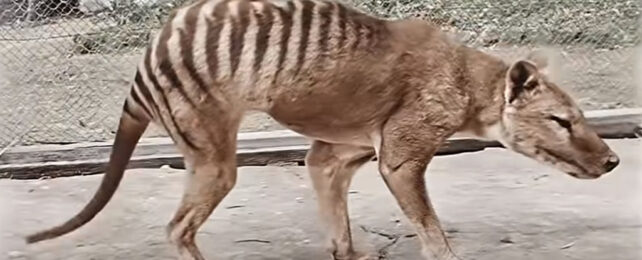Nobody writes an obituary for the last of a species dying alone in the wild. So, knowing precisely when to confirm an extinction comes down to a mix of clever sleuthing, mathematics, and no small amount of guesswork.
On 7 September 1936, a thylacine (Thylacinus cynocephalus) held captive in a small Hobart zoo became the last Tasmanian tiger ever to be seen drawing a breath.
Officially, at least. Reports of 'marsupial wolf' sightings in the rugged island wilderness continued well beyond the 1930s, gradually fading to whispers as the world finally came to accept the iconic native Australian creature really was gone for good.
Based on the suspicious lack of verifiable observations, including prints and remains, the International Union for the Conservation of Nature closed the chapter on Tasmanian tigers in 1986.
Now, a fresh investigation into a likely timeline for the last days of the thylacine has been published, confirming the species was most probably extinct before then.
Led by scientists from the University of Tasmania, a team of researchers gathered an exhaustive collection of 1,237 sighting reports and developed a new method for calculating the distribution of post-bounty thylacine holdouts, finding the last individuals were gone by the 1970s.
That is, at least, going by reports that have the highest chance of being reliable. There's a world of difference between the word of a practiced trapper written in the 1960s, and Uncle Frank's moonshine mutterings of the striped dog he swore he glimpsed on his roof last year.
Categorizing the stories on a spectrum of trust-worthiness provides a little more wiggle-room in conclusions, allowing for the possibility of small populations persisting well into the 1990s, years after authorities declared them to be extinct.
If we stretch credibility to breaking point, there's a slim, if extremely unlikely chance a handful of thylacines could still be lurking in the state's remote south-west to this day.
Australia's island state was already a refuge for the Tasmanian tiger by the time Europeans arrived in the early 19th century, with a population of maybe a few thousand of the large carnivorous marsupials persisting in the island's woodland ecosystem, after dying out on the mainland thousands of years prior.
Looking too wolf-like for the colonist's comfort, it didn't take long for the traps and bounties to do their work. Incidental snaring by fur traders and the occasional caging for exotic animal trade drove the last populations into remote reaches of the rugged Tasmanian terrain. Habitat destruction and disease no doubt took a toll as well, making it all but impossible for the species to recover.
Yet in spite of the animal's notoriety, there's a surprising lack of hard data informing speculations on their demise.
Keeping in mind the challenges of relying too heavily on anecdotes, the researchers behind this latest effort to definitively pin down a date for the animal's extirpation dug through government archives, newspaper articles, museum collections… anything that said anything on the existence of wild Tasmanian tigers from 1910 onwards.
Curating the collection according to dates, locations, type, and quality, the team applied several statistical techniques to come up with a spectrum of plausible scenarios detailing when the last true observation was likely to have taken place.
If we rely solely on confirmed physical specimens, the last thylacine died in the wild a mere five years after the death of its captured cousin. Include more dubious specimens, the lower boundary for extinction could stretch into the 1950s, with a chance that some may have survived into the following decades.
Throw in some high-quality, if uncertain glimpses, or perhaps a few sightings by multiple witnesses, it's possible thylacines were still skulking in the brush when Bill Clinton became president.
Want to take every single report into account (including Uncle Frank's)? There's a slim chance there just might be a few families hiding away out there still.
Just don't hold your breath. Though the data implies thylacines lasted longer than we might have thought, scientifically speaking they are just as extinct. Short of some kind of numbat hybridization program attempting to bring them back in limited form, the Tasmanian tiger is no more.
If there's any hope, it's for the many species now on the brink of extinction which we can still save if we learn a lesson or two from the tragic tale of Tasmania's mistaken wolf.
This research was published in Science of the Total Environment.
